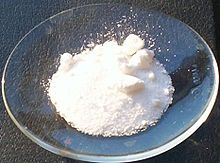Sodium disulfite
| Structural formula | ||||||||||||||||
|---|---|---|---|---|---|---|---|---|---|---|---|---|---|---|---|---|

|
||||||||||||||||
| General | ||||||||||||||||
| Surname | Sodium disulfite | |||||||||||||||
| other names | ||||||||||||||||
| Molecular formula | Na 2 S 2 O 5 | |||||||||||||||
| Brief description |
white to yellowish crystalline solid with a pungent odor |
|||||||||||||||
| External identifiers / databases | ||||||||||||||||
|
||||||||||||||||
| properties | ||||||||||||||||
| Molar mass | 190.11 g mol −1 | |||||||||||||||
| Physical state |
firmly |
|||||||||||||||
| density |
2.36 g cm −3 at 20 ° C |
|||||||||||||||
| Melting point |
Decomposition from 150 ° C |
|||||||||||||||
| solubility |
light in water (approx. 650 g l −1 at 20 ° C) |
|||||||||||||||
| safety instructions | ||||||||||||||||
|
||||||||||||||||
| MAK |
Switzerland: 5 mg m −3 (measured as inhalable dust ) |
|||||||||||||||
| As far as possible and customary, SI units are used. Unless otherwise noted, the data given apply to standard conditions . | ||||||||||||||||
Sodium disulfite , (Na 2 S 2 O 5 ) also called sodium pyrosulfite or sodium metabisulfite , is a sodium salt of disulfurous acid , which is not stable in its free form .
Sodium metabisulfite can with sodium especially easy bi be confused sulfite, an older but still common names for sodium bisulfite .
synthesis
It is produced by thermal dimerization ( condensation ) of sodium hydrogen sulfite with elimination of water (1), or by converting sulfur dioxide and sodium sulfite into sodium hydroxide solution (2):
properties
Disulfites have a very long and therefore not very stable sulfur- sulfur bond. In water, therefore, hydrolysis to sodium hydrogen sulfite easily takes place :
When the salt is heated, thermal decomposition occurs with the elimination of sulfur dioxide (SO 2 ):
use
In Germany, sodium disulfite is used as a food additive (E 223) primarily as a preservative and antioxidant . It is used in dried fruits , horseradish mass , fruit and vegetable preparations, potato dishes, ready meals, fruit juices and jams. It is also used in combination with sorbic acid and benzoic acid . It can be used for diagnosing sickle cell tests in order to remove oxygen from the hemoglobin in sickle cell anemia and to accelerate sickle formation.
Sodium disulfite is also used as a reducing agent in the manufacture of man-made fibers, to detoxify waste water containing chromium in electroplating plants, as well as in the photo industry and construction chemistry.
Health advice / risk assessment
In most people, sodium disulfite in the concentrations present in food is quickly broken down by an endogenous enzyme, but otherwise it would lead to nausea, vomiting, diarrhea and headaches. In asthmatics , it may Sulfitasthma trigger; in addition, allergic and allergy-like reactions are possible, albeit rarely. Sodium disulfite destroys vitamin B1 ( thiamine ) in food .
Sodium disulfite was included in the EU's ongoing action plan ( CoRAP ) in 2014 in accordance with Regulation (EC) No. 1907/2006 (REACH) as part of substance evaluation . The effects of the substance on human health or the environment are reassessed and, if necessary, follow-up measures are initiated. The causes of the uptake of sodium disulfite were concerns about environmental exposure, exposure of sensitive population groups , high (aggregated) tonnage and widespread use, as well as the dangers arising from a possible assignment to the group of CMR substances. The re-evaluation took place from 2014 and was carried out by Hungary . A final report was then published.
Individual evidence
- ↑ Entry on E 223: Sodium metabisulphite in the European database for food additives, accessed on June 27, 2020.
- ↑ entry to Sodium Metabisulfite in CosIng database of the European Commission, accessed on 21 March 2020th
- ↑ a b c d e f record with sodium metabisulfite in GESTIS database of IFA , retrieved on Feb. 22, 2017 (JavaScript required)
- ↑ Entry on Disodium disulphite in the Classification and Labeling Inventory of the European Chemicals Agency (ECHA), accessed on February 1, 2016. Manufacturers or distributors can expand the harmonized classification and labeling .
- ↑ Swiss Accident Insurance Fund (Suva): Limits - Current MAK and BAT values (search for 7681-57-4 or sodium disulfite ), accessed on November 2, 2015.
- ↑ Grillo-Werke AG | SODIUM PYROSULPHITE . ( grillo.de [accessed November 8, 2018]).
- ↑ a b sodium disulfite (zuatzstoffe-online.de)
- ↑ E 223 - Sodium metabisulphite; Sodium disulfite (das-ist-drin.de)
- ↑ Entry on sulfur dioxide. In: Römpp Online . Georg Thieme Verlag, accessed on February 8, 2016.
- ^ European Chemicals Agency (ECHA): Substance Evaluation Report and Conclusion Document .
- ↑ Community rolling action plan ( CoRAP ) of the European Chemicals Agency (ECHA): Disodium disulphite , accessed on March 26, 2019.






